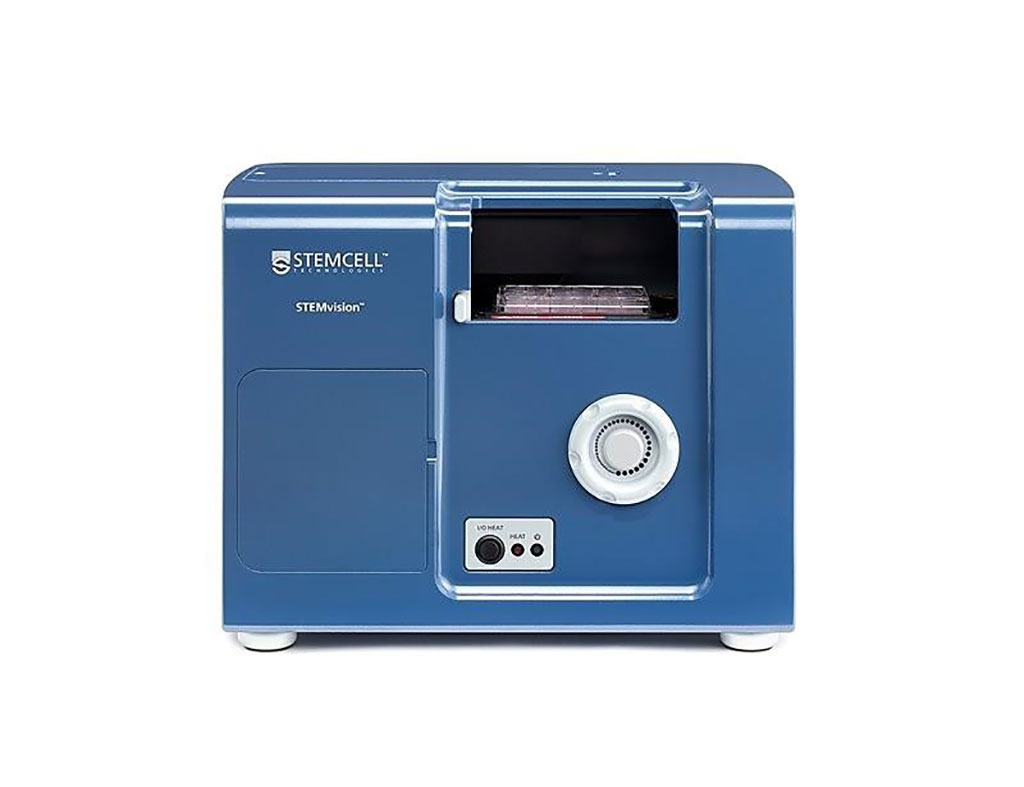Chronic Lymphocytic Leukemia Increases Peripheral Blood Hematopoietic Stem Cells
By LabMedica International staff writers
Posted on 31 Dec 2020
Chronic lymphocytic leukemia (CLL) is an indolent B-cell malignancy invariably infiltrating the bone marrow. The disease remains incurable, and after emergence of therapy, resistant disease patients succumb to infections because of secondary bone marrow failure. Posted on 31 Dec 2020
The underlying mechanisms impairing normal hematopoiesis in patients with CLL are poorly defined. Mature, differentiated B cells, either pre- or post-germinal center, are considered the cell of origin of unmutated and mutated CLL, respectively. However, this paradigm has been challenged based on the observation of CLL-recurrent mutations present in a fraction of hematopoietic stem cells (HSCs).

Image: STEMvision: Automated and standardized colony counting for the hematopoietic colony-forming unit (CFU) assay (Photo courtesy of STEMCELL Technologies).
Hematologists at the MRC Cambridge Stem Cell Institute (Cambridge, UK) and their colleagues assessed the frequency of hematopoietic stem and progenitor cells (HSPCs) in the peripheral blood (PB) of 69 individual patients with the diagnosis of CLL, and 21 age-matched healthy controls. PB samples were collected in the afternoon, when circulation of hematopoietic progenitors is known to reach its peak because of circadian oscillation.
To assess the absolute numbers of CD34+ cells, non-purified peripheral blood mononuclear cells from 5 mL PB were stained and gated for CD34 positivity and CD19 negativity to quantify the total amount of circulating hematopoietic progenitor cells, using precision counting beads (Biolegend, San Diego, CA, USA) and flow cytometry. Relative frequencies of HSPC subsets were assessed on CD34+-enriched cells using beads (Miltenyi Biotec, Bergisch Gladbach, Germany).
To assess differentiation capacity of HSPCs, 1 × 103 or 6 × 103 CD34+ cells were plated in duplicate in complete semisolid methylcellulose (STEMCELL Technologies, Vancouver, BC, Canada). Differentiated colonies were counted and scored based on morphology 14 days after culture in a humid environment at 37 °C using STEMCELL Technologies’ STEMVision camera and software.
The investigators reported that the absolute numbers of circulating HSPCs and found similar numbers of CD34+ cells to age-matched healthy individuals. The analyses revealed that common myeloid and myeloerythroid progenitors (CMPs-MEPs) (CD19−CD34+CD38+CD45RA−CD10−CD7−) were more abundant in the PB of patients with CLL. Conversely, myelolymphoid progenitors (CD19−CD34+CD38−CD45RA+) were significantly decreased in patients’ blood compared with healthy controls. The HSC pool (CD19−CD34+CD38−CD45RA−), defined as a pool of HSC and multipotent progenitors, is known to contain a heterogeneous pool of cells with different self-renewal and differentiation capacities, and was also more abundant in patients’ blood.
The authors concluded that their data provide further insights on the mechanisms causing cytopenia in patients with CLL and suggest that a pathologic mobilization of ST-HSCs is a contributing factor. The study was published on December 18, 2020 in the journal Blood Advances.
Related Links:
MRC Cambridge Stem Cell Institute
Biolegend
Miltenyi Biotec
STEMCELL Technologies














